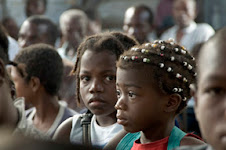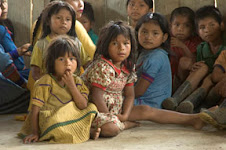skip to main |
skip to sidebar
Here in Colombia, I’m very used to getting a lot of praise for my photography, and for the way I carry it out, engaged with the communities I visit here in El Chocó. This praise comes from people in the art world, in journalism, and from the communities themselves and the organizations that work with them, and with which I try to cooperate and provide support. In addition, I’m accustomed to getting occasional email notes that are also very positive. (Back in Cleveland, I’m unaccustomed to such praise, but that’s a story for another time…) Maybe I was getting too comfortable with so much praise.
But not to worry about that. Recently, I received a note that took a totally different approach. I’ll reproduce it here, then give you a translation:
“Vi sus fotos. Que magnífico ejemplo de espectaculo vacío. Sus imágenes poco colaboran para poner en contexto la violencia en Colombia. Creo que el suyo, es un intento de trascender en su propia sociedad, exotizando a "los otros", personas a quienes poco importa si un fotografo del primer mundo les toma una fotografía para prostituirlos o no. La calidad de la composicion además, es de baja calidad y deja tantos vacíos que da asco.”“I saw your photos. What a magnificent example of an empty spectacle. Your images cooperate little in putting the violence in Colombia in context. I think what you’re doing is an attempt to succeed in your own society, exoticizing “the others,” people to whom it matters little if a photographer from the first world takes a picture to prostitute them or not. The quality of the composition in addition is low quality and leaves so many holes that it’s revolting.”What’s most interesting about this is that even if I were inclined to answer (which I am certainly not), I’d have the problem that I can’t tell if this attack is coming from the extreme right or the extreme left—they could both take this position.Well, I’ll post a couple of pictures below (after the Spanish translation) to make this more interesting for you-all.Otra Vista a mi Trabajo:Aquí en Colombia, estoy muy acostumbrado a recibir muchos elogios por la fotografía mía, y por la manera en que la realizo, involucrado con las comunidades que visito acá en El Chocó. Este elogio viene de gente en el mundo del arte, del periodismo, y de las comunidades mismas y las organizaciones que trabajan con ellas, y con las cuales intento colaborar y proporcionar apoyo. Además, estoy acostumbrado a recibir de vez en cuando unas notas por correo electrónico que también son muy positivas. (Allá en Cleveland, no recibo semejante elogio, pero esto es cuento para otra ocasión...) Quizás me volvía demasiado cómodo con tanto encomio.
Pues, no hay que preocuparse por eso. Últimamente recibí una nota que toma posición totalmente contraria.Acá la reproduzco:“Vi sus fotos. Que magnífico ejemplo de espectaculo vacío. Sus imágenes poco colaboran para poner en contexto la violencia en Colombia. Creo que el suyo, es un intento de trascender en su propia sociedad, exotizando a "los otros", personas a quienes poco importa si un fotografo del primer mundo les toma una fotografía para prostituirlos o no. La calidad de la composicion además, es de baja calidad y deja tantos vacíos que da asco.”
Lo más curioso es que aún si estuviera dispuesto a contestar (el cual seguramente no estoy), tendría el problema que no puede estar seguro si este asalto vino desde el extremo de la izquierda o la derecha—ambas pueden asumir esta posición.
Pues pongo un par de fotos para darles algo que les interese más.


I arrived in Medellín the night of July 18, and left for Quibdó August 11. In these three weeks I worked at an exhausting pace, conducting classes and workshops for the University of Antioquia en Medellín and the coastal town of Turbo, working with a group of artists to put together the “laboratory” at the Centro Colombo-Americano on daily resistance (here are two good links, a and b), giving a couple of talks, participating in the Encuentro de Fotografía-Medellín 2008, and more. I had very little time off, which was OK because this was good work, and I felt I was making a real contribution. But unfortunately the pressure of time meant I have been very far behind in writing posts for the blog, and that I took few pictures in Medellín. In the days and weeks that come I expect to finally post some entries about these experiences, but for the time being, to make sure you know I haven’t forgotten about you, I’ll just post a few pictures that you might enjoy not so much for social content as for a general view of some of the beauty of the area.
Llegué a Medellín la noche del 18 de Julio, y salí para Quibdó el 11 de agosto. En estas tres semanas trabajé a un paso muy agotador, dictando clases y talleres para la Universidad de Antioquia en Medellín y el pueblo costeño de Turbo, trabajando con un grupo de artistas para montar el “laboratorio en el Centro Colombo-Americano sobre el tema de la resistencia cotidiana (estos son dos lazos buenos, a y b), dictando unas charlas, participando en el Encuentro de Fotografía-Medellín 2008, y más. Tuve muy poco tiempo libre, que fue bien porque este fue un buen trabajo, y sentí que aportaba algo real. Pero desafortunadamente, por la presión de tiempo he estado muy atrasado en escribir entradas para el blog, y por la misma saqué pocas fotos en Medellín. En los días y las semanas venideros espero por fin poner unas entradas sobre estas experiencias, pero para mientras, para asegurar que sepan que no les haya olvidado, pondré unas cuantas fotos que posiblemente les gusten no tanto por su contenido social, como por una vista general de parte de la belleza de la zona.
 Santa Elena, in the mountains above Medellín, is one of the centers of the flower-growing industry. Although I have serious reservations about the sustainability and internal practices of that industry, there's no doubt about the beauty of some of the cultivated and native flowers.Santa Elena, en la montaña arriba de Medellín, es uno de los centros de la industria de floricultura. Aunque tengo dudas serias sobre la sostenibilidad y prácticas de esa industria, no cabe duda de la belleza de algunas de las flores, tanto cultivadas como nativas.
Santa Elena, in the mountains above Medellín, is one of the centers of the flower-growing industry. Although I have serious reservations about the sustainability and internal practices of that industry, there's no doubt about the beauty of some of the cultivated and native flowers.Santa Elena, en la montaña arriba de Medellín, es uno de los centros de la industria de floricultura. Aunque tengo dudas serias sobre la sostenibilidad y prácticas de esa industria, no cabe duda de la belleza de algunas de las flores, tanto cultivadas como nativas. Guadua, a native bamboo of Colombia. It gives its name in Embera to the river, Chigorodó, which is also the name of a town in the Antioquian Uraba, near the Caribbean coast.Guadua, un bambú nativo de Colombia. Presta su nombre en embera al río, Chigorodó, que también es nobre de un pueblo en la Urabá antioqueña, cerca la costa caribeña
Guadua, a native bamboo of Colombia. It gives its name in Embera to the river, Chigorodó, which is also the name of a town in the Antioquian Uraba, near the Caribbean coast.Guadua, un bambú nativo de Colombia. Presta su nombre en embera al río, Chigorodó, que también es nobre de un pueblo en la Urabá antioqueña, cerca la costa caribeña Río Chigorodó, the Bamboo River in Embera.Río Chigorodó, el río de guadua en embera.
Río Chigorodó, the Bamboo River in Embera.Río Chigorodó, el río de guadua en embera. Cargo boats in Turbo, the main port in the Antioquian Urabá.Lanchas de carga en Turbo, el puerto principal de la Urabá antioqueña.
Cargo boats in Turbo, the main port in the Antioquian Urabá.Lanchas de carga en Turbo, el puerto principal de la Urabá antioqueña.
 The Antioquian Urabá is an area of vast banana plantations, while in the Chocoan Urabá, the main crop is plátano.La Urabá antioqueña es una zona de vasta plantaciones bananeras, mientras en la chocoana, la cosecha principal es el plátano.
The Antioquian Urabá is an area of vast banana plantations, while in the Chocoan Urabá, the main crop is plátano.La Urabá antioqueña es una zona de vasta plantaciones bananeras, mientras en la chocoana, la cosecha principal es el plátano. The view of the mountains as you approach Medellín from the north.La montaña vista al acercarnos a Medellín desde el norte.
The view of the mountains as you approach Medellín from the north.La montaña vista al acercarnos a Medellín desde el norte.
 At the entrance to the cathedral in Ríonegro, the city which houses the international airport that serves Medellín.Al portón de la catedral de Ríonegro, la ciudad donde se encuentra el aeropuerto internacional que sirve a Medellín.
At the entrance to the cathedral in Ríonegro, the city which houses the international airport that serves Medellín.Al portón de la catedral de Ríonegro, la ciudad donde se encuentra el aeropuerto internacional que sirve a Medellín.












